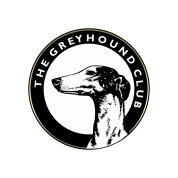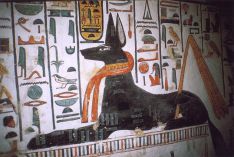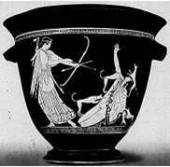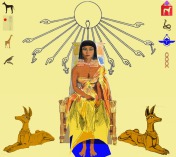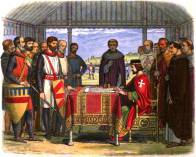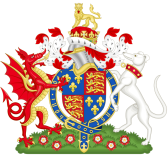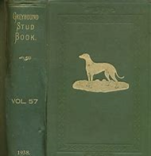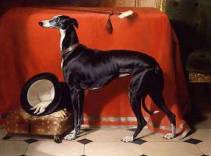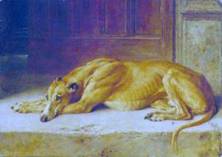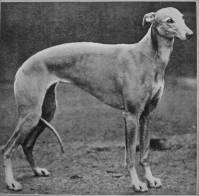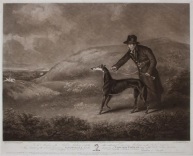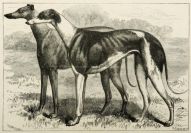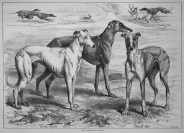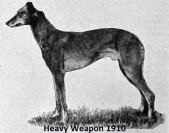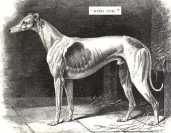About the Greyhound
Origins
The Greyhound is a sighthound and one of the oldest breeds of dogs. Sighthounds are hunting dogs that pursue running game by sight rather than by scent. This manner of hunting is called
“coursing”. The attributes of speed, agility, strength and endurance are necessary to catch and hold game. The feature that distinguishes Greyhounds (and sighthounds) is their ability to run at
speeds in excess of 35 miles per hour using the double suspension gallop. The Greyhound demonstrates the double suspension gallop in its highest perfection. Their incredible speed comes from the
singular combination of skeletal structure, musculature, and the ability to focus completely on the object of the chase.
Greyhounds and other sighthounds course game independently of humans. Sighthounds are unlike other breeds of dogs in that they take no signals from humans. Once the chase is on and the Greyhound is
on its way, there is very little you can do to intervene until the chase is over. Herding dogs take commands from handlers when moving sheep from pasture to pen or sporting dog breeds that search and
point and hold birds in one spot until their human indicates it’s time to flush.
Centuries of careful and selective breeding have yielded one of the most incredible breed of dogs, the Greyhound. Many people are familiar with the streamlined body and the incredible athletic skills of the Greyhound. These marvelous features do not appear to have changed much since the ancient times. You will even find references to the Greyhound or Greyhound-liked dogs in art work, pottery pieces, and literature and even inside the royal tombs of the Egyptian Pyramids. What is the exact origin of the Greyhound breed? No-one is really sure of this. There is a line of thought that this breed originated from Africa, ancient Greece, the Middle East or even Turkey. However, it is widely known that the Greyhound breed has a bloodline that literally goes back thousands of years making it the oldest bloodline for dogs. Indeed the oldest pedigree held by the Kennel Club is that of a Greyhound.
In Egypt, the ancestors of modern Greyhounds were used in hunting and kept as companions. Many Egyptians considered the birth of a such a hound second in importance only to the birth of a son.
When the pet hound died, the entire family would go into mourning.
The favourite hounds of the upper class were mummified and buried with their owners. The walls of Egyptian tombs (pictured left) often were decorated with images of their hounds. An Egyptian tomb
painting from 2200 BC portrays dogs that looks very much like the modern Greyhound. Among pharaohs known to own Greyhound-type dogs are Tutankhamen, Amenhotep II, Thutmose III, Queen Hatshepsut, and
Cleopatra VII (of Antony and Cleopatra fame).
(Cleopatra pictured below)
The Greek gods were often portrayed with greyhounds. A hound often accompanies Hecate, the goddess of wealth. The protector of the hunt, the god Pollux, also is depicted with hounds.
One myth tells of how a human named Actaeon came upon the goddess Artemis taking a bath in a river. She punishes his impropriety by turning him into a stag. He is then hunted down by his own
hounds
This great Greek historian Lucius Flavius Arrianus ‘Arrian’ (ca. 86 - 160 )wrote a book called ‘TheTreatise on the Greyhound’ in the 2nd century.
First, let them stand long from head to stern…..let them have light and well knit heads….let the neck be long, rounded and supple….broad breasts are longer than narrow and let them have shoulder
blades standing apart and not fastened together…. loins that are broad, strong not fleshy, but solid with sinew………flanks pliant….rounded and fine feet are the strongest’
The Egyptian god Anubis, either a jackal or a hound-type dog, is frequently displayed on murals in the tombs of the Pharaohs. Some depictions of it look much like the modern Pharaoh Hound, a close relation of the Greyhound.
The only breed of dog mentioned by name in the Bible is the Greyhound (Proverbs 30:29-31, King James Version):
There be three things which do well, yea,
Which are comely in going;
A lion, which is strongest among beasts and
Turneth not away from any;
A greyhound;
A he-goat also
.
In fact, Greyhounds have a bloodline that runs all the way back to approximately 4,000 years. Greyhounds have been selectively and carefully bred throughout the years for their speed characteristic. The Greyhound is part of the sight hound breed which accounts for the Greyhound’s ability to see approximately half a mile away! Sight hound breeds are known for their uncanny, natural instinct to give chase. The Greyhound is known to travel as fast as 45 miles per hour in just three simple strides forward. The combination of the sight, incredible speed and instinct to give chase is the reason for the Greyhound’s popularity to be used specifically for hunting. Many people are under the misconception that the name Greyhound would mean a grey coloured dog. The closest colour among the breed is the blue or steel colours. However, these are not common at all in the Greyhound breed. One popular belief is that the name Greyhound actually came from the term gazehound that actually means sight hound. Other beliefs of the origin of the term Greyhound focus around various meanings or translations for the word Greyhound or for specific characteristics for the breed. For example, the Greek words Graius, gracillius mean slender or sleek which is a respected feature of the Greyhound breed. Another example is the British words, grech or greg which simply means dog, combined with hundr which translate to hunter.
Prior to the Middle Ages, it appeared as though these swift hounds lost their place among the great halls of the privileged, especially when many famines swept the lands. Yet the resilient breed
over time once again endeared themselves to royalty, and again became features in their courts.
Moreover, the nobles became so enamored of their phenomenal hunting dogs that it was a capital offense to kill a Greyhound. Human life at times was valued less than the life of one such dog. Before
long, commoners were forbidden from owning these dogs, and it was only the noble who had permission from the king to own and breed Greyhounds.
As the middle ages gave way to the age of enlightenment, the status of the Greyhound did not significantly shift. Although they were no longer valued above human life, they still were considered one
of the premier status symbols that a man of means could aspire to. This explains their presence in many of the portraits commissioned by the wealthy and notable clientele of the famous painters of
the age.
Before long the hunt was no longer considered a worthwhile endeavour and the man of means became the man of business. While balancing ledgers and overseeing factories, the highly bred sporting dogs
were put to use in the arenas of sports, where their agility once again became a highly prized asset. What may have originally been little more than a friendly competition amongst business rivals
soon turned into a full-fledged gaming venture; dog racing soon rivalled horse racing in popularity.
Greyhounds in the UK
In SW Wales in AD 500 there is mention that 2 white breasted brindle greyhounds ran besides Prince Kilburgh as he travelled to Arthurs Court. These dogs wore broad collars, set with
rubies, and they were said to have sprung about their owner like two sea swallows.
The Forest Laws in 1016, made at Winchester by King Canute, forbade ‘ commoners’ owning greyhounds.
By 1200 one third of English countryside was set aside for coursing and falconry.
At the time of the Magna Carta (1215) greyhounds were held in such high esteem that destruction of one was seen as an act equally criminal with the murder of a fellow man!
About this time greyhounds were also taken as payment for fines – there is record in 1203 of a fine paid to King John of 500 marks, 10 horses and 10 leashes of greyhounds
Fast forward 100 years and the black death/plague in 1347 hit the country killing both gentry and commoners – courts in disarray so allowed commoners to break rules – they kept black and brindles so couldn’t be seen at night, whilst the gentry kept white to symbolise power and purity and to be seen from the saddle! This wring is 1000 years on from what we saw earlier but not dissimilar . This book is basically a translation from a French book called Book of the Hunt, however it is thought the section on the greyhound is his own writing.
The Ideal Greyhound from Edmund de Langley's Mayster of Game, AD 1370.
The Greihound should have a long hede and somedele grete, ymaked in the manner of a luce; a good large mouth and good sessours, the one again the other, so that
the nether jaws passe not them above, ne that thei above passe not him neither.
The neck should be grete and long, and bowed as a swanne's neck.
Her shuldres as a roebuck; the for leggs streght and gret ynow, and nought to hind legges; the feet straught and round as a catte, and great cleas
the boones and the joynetes of the cheyne grete and hard as the chyne of an hert; the thighs great and squarred as an hare; the houghs steight, and not crompyng as of an oxe.
A catte's tayle, making a ring at eend, but not to hie.
It is clear he had a hatred of all things French so it is ironical that he died as one of the few English fatalities at the battle of Agincourt n 1415! another interesting point is that he writes the best colour is red with a black mask. Latterly racing owners would say tat this colour is the marker of a fighter on the track and not loved!
The Tudors
There is much evidence that both King Henry VII and VIII and Queen Elizabeth I enjoyed greyhounds, but not only chasing the usual prey of hares but deer too between the paddocks and woods.
The early rules of judging greyhound coursing were drawn up by Thomas Howard, fourth duke of Norfolk at the desire of Queen Elizabeth 1, this necessity for a code of practice for the sport confirms its growing importance in the 16th century
18th Century
The 3rd Earl of Orford created the first coursing club open to the public in 1776 at Swaffham in Norfolk.
Lord Orford had well over a 100 greyhounds at a time and did not get rid of one until it had been given a fair and substantial trial of speed.
Lord Orford is said to have crossbred greyhounds with several breeds, including the bulldog, in pursuit of greyhounds with greater stamina. His efforts were generally unsuccessful.
Perhaps the typical small ear may derive from the bulldog cross.
It was at this time breeders began to keep proper pedigrees of their dogs therefore the greyhound is lucky to be able to trace their pedigrees back further than most breeds. The story goes that
on the day his famous bitch Czarina was to run a match on Newmarket Heath, Orford escaped from incarceration by his family due to his supposed insanity. The old man, without a topcoat on a freezing
winter's day and clad only in his customary black suit and tricorn hat, watched Czarina defeat Maria, raised his hat to his bitch, and fell back off his pony stone dead. The course is said to have
taken place on Chippenham field which in those days stretched from Chippenham Park across to the Limekilns gallops on the Bury Road where the noble lord expired. As Czarina is reckoned to have been
whelped in 1781, she would have been ten at the time and won 47 matches without loss
19th Century
The popularity of greyhound coursing in Britain increased greatly during this period. The Industrial Revolution gave the manufacturing classes the wealth and time to enjoy social activities,
and the expansion of rail made it easier to get to coursing events. In 1882 the National Coursing Club published its first Greyhound Stud Book, the original breed register. From 1882 onwards the
greyhound breed was closed and the pedigrees of purebred greyhounds were established fact rather than apocryphal
Greyhounds were exported to North America in large numbers from Ireland and England in the mid-1800s to help rid midwest farms of a virtual epidemic of jackrabbits that was ruining their farms.
Greyhounds also were used to hunt down coyotes who were killing livestock.
Greyhounds remained a familiar sight among the royalty and nobility of England
The husband of Queen Victoria had a pet black and white greyhound, Eos (pictured right).An unfortunate accident happened to Eos on January 27th 1842 when Queen Victoria’s uncle, Ferdinand of Saxe
Coburg Gotha, shot her instead of the game. The Queen and the Prince were greatly distressed. In a letter to her uncle, Leopold I, King of the Belguims, the Queen wrote on February 1st
1842, “You have heard our great misfortune about dear Eos; she is going on well but slowly, and still makes us rather anxious. It made me quite ill the first day and keeps me fidgety still till
we know that she is quite safe”.
In his reply on February 4th King Leopold wrote, “I was extremely sorry to hear of the accident which befell dear Eos a great friend of mine. I do not understand how your uncle managed it: he
ought rather to have shot somebody else in the family”.
Fortunately Eos did recover and lived for another year and a half.
So to the 20th century – we start with this beautiful painting at the Kennel Club – Painting called the open door and features Dog called Long Span in the twilight of his career – her belonged to Sir Robert Jardine and won Waterloo in 1907 Painted by Briton Riviere RA
The first dog shows were held in Newcastle in 1852
Greyhound fanciers showed their dogs but usually out of season so as not to affecting their coursing
The concept of CCs as we know them today started in 1890s
Most of the early judges were from the coursing field, but gradually more and more ‘all rounders’ came in and the coursing fraternity did not like the results not corresponding with field
results.
Numbers dwindled and there were very low numbers shown in the early 1900s
First UK Greyhound Champion after CCs allocated. Ch Annie Laurie II. Ch Real Jam 2nd UK Greyhound Champion
CH Primely Sceptre (pictured right) - the first greyhound to win BIS at Crufts in 1928 since the title started in 1926. Owned by Mr Whitley – founder and owner of Paignton Zoo at the
same time as this was going on the first racing track got going in the UK. The sport emerged in its recognizable modern form, featuring circular or oval tracks, with the invention of the mechanical
or artificial hare in 1912 by Owen Patrick Smith.
The first recorded attempt at racing greyhounds on a straight track in Hendon in 1876, however it wasn’t until 1926 that it fully took off and by the end of 1927, there were forty tracks
operating. Dogs have been selectively breed for short bursts of speed since then and are noticeably different to both the show and coursing bred greyhounds
. Greyhound Derby first held at White City Stadium in 1927 but moved to Wimbledon in 1985 and Latterly Towcester.
Perhaps the most famous of all is Mick the Miller, the smallest of 12 puppies. . Mick won the greyhound derby in 1929 and 1930.Only four have won the derby twice Mick the Miller, Patricia's Hope, Rapid Ranger and most recently Westmead Hawk.
An old charter dictates that a brace of greyhounds are presented to the Duke of Cornwall as part of the terms of tenure, hence often called the national dog of Cornwall
The show greyhound as we know it, developed in from 1910 - 40s in Cornwall. St Blaise was one such dog who won CC at Crufts in 1913 and was bought for 90 guineas (unshown)
In his book The Greyhound (1930) James Matheson states ‘so far as the requisites for a show dog are concerned, there were very few really bad specimens in Cornwall.’
The Greyhound Club was founded in 1948 and most of the founders were from Cornwall.
Sadly for the UK so many greyhounds went to USA in 1930s from Cornwall and are behind many of the showlines there today
We have already seen some good descriptions from many centuries ago that have stood the test of time.
The foundation of the Kennel Club in 1873 saw them take ownership of the breed standards which had been drafted by the early breeders
The greyhound breed standard was written in the 1940s for the Greyhound Club by the then Chairman, Mr Opie. It is said it was based on his own greyhound, Ch Lady of Lelant.
This did not change until 1980s when breed standards updated so that all breed standards followed standard terminology. This time movement was added in and the loin was changed from being
described as arched to slightly arched.
Images below are of the most famous coursing meeting the Waterloo Cup.
The Waterloo Cup was a coursing event organised by the National Coursing Club. The three-day event was run annually at Great Altcar in Lancashire, England from 1836 to 2005 and it used to attract tens of thousands of spectators to watch and gamble on the coursing matches. It was founded by The 2nd Earl of Sefton and, originally, was supported by his patronage.
Fleck of hare fur from the last Waterloo Cup meet, February, 2005.
It was the biggest annual hare coursing event in the United Kingdom and was often referred to by its supporters as the blue riband event of the coursing year. A hare coursing event of identical name
was held in Australia from 1868 to 1985, at which point it became a lure coursing event. Run as a knock-out tournament between sixty four coursing Greyhounds from Great Britain and Ireland,
supporters described it as the ultimate test of a Greyhound but opponents of hare coursing, such as the League Against Cruel Sports, saw it as a celebration of cruelty. The Hunting Act 2004, which
came into force just after the 2005 cup, made hare coursing events illegal in England and Wales, and the Waterloo Cup has not taken place since.
